Ease Stress – But Quickly, Please
The positive effect of aromatherapy on humans has been known for a long time. The effect is essentially based on the stimulation of the olfactory receptors in the nose. Certain smells have a relaxing and stress-reducing effect. Recent research has shown that the skin also has olfactory receptors and even bitter receptors that can be activated with appropriate molecules. In the keratinocytes, differentiation and maturation are thus stimulated via an induced influx of calcium. Here we show how a cosmetic active ingredient with a pleasant fragrance profile both reduces stress, detected by measuring stress hormones, and positively influences the skin by activating bitter receptors. -> back to main page
Introduction
From functional fragrances to active ingredients with a scent
Many essential oils are used since thousands of years for aroma therapies. When used as a fragrance oil or perfume, it not only makes you smell good, but also has effects on your state of mind. It has long been known that the scents of rosemary, citrus or pine have stress-relieving effect. Rosemary, for example, can reduce the level of the stress hormone cortisol [1]. Citrus scents can have anti-depressive effects. Both are a good choice for stress reduction and mood enhancement. A Japanese study found that a walk through a pine forest (Shinrin Yoku) significantly reduces anxiety, depression and stress [2] and can even be prescribed by the doctor. A main ingredient of the pine scent is the fragrance cedrol. A tiny amount of it is already able to lower blood pressure and heart rate when inhaled. The inhalation of cedrol induces an increase in parasympathetic neural activity and reduces sympathetic activity, in line with its relaxing effect [3]. The parasympathetic nerve is also called the resting nerve. It controls our organ functions in the background and cannot be controlled consciously. Activation of it facilitates relaxation, a good sleep and regeneration. Recently, it was discovered that fragrance molecules cannot only be detected by receptors in our nose, but the very same olfactory receptors are present on skin cells as well [4]. Additionally, bitter molecules can be “tasted” by the skin with corresponding bitter taste receptors.
The effectiveness of fragrant cosmetic ingredients on the skin is not only traditionally handed down (keyword Ayurveda) but is more and more scientifically described. Sandalore, for example, a fragrance from sandalwood, can have a positive influence on the differentiation and maturation of the keratinocytes and strengthen the skin barrier [5]. Bitter flavors like amarogentine bind to bitter taste receptors and have a similar effect [6]. During ageing or in stressful situations, our skin loses its important calcium gradient [4, 7] and the skin can look dry and dull. However, a flawless, radiant skin depends on an excellent skin surface structure and an intact skin barrier. When it comes to an extraordinary, radiant complexion, calcium regulating active ingredients are a good choice. Considering that small amounts of a fragrance are sufficient to induce unconscious positive reactions of the body and mind via the sense of the smell, it is easy to understand that tiny amounts will also have an effect on skin. Plant extracts with a certain proportion of fragrant molecules, but which are not perfume oil, are particularly suitable here.
The nose and tongue of the skin
Bitter taste and olfactory receptors not only exist on the tongue and in the nose but are also present on skin cells, especially [6, 8]. This was long time not expected and not recognized as the concentration of these receptors on the cell surface is rather low. However, the specific ligands for corresponding receptors just need a tiny concentration to evoke a signal. Many different bitter taste and olfactory receptors were already detected in skin cells [9], recently also in fibroblasts.
Olfactory receptors
The signaling cascade of olfactory and taste receptors in keratinocytes is complex. As keratinocytes are not able to depolarize in a way that facilitates an electrochemical signal to the brain, the inflowing calcium is used differently. Following several steps, transcription factors are activated binding to the corresponding promoters on the DNA. This facilitates keratinocyte maturation and differentiation leading to a strong and healthy skin barrier (Figure 1) [4].
Taste receptors
Taste receptors have a different G-protein subset. Instead of activating the adenylate cyclase, they can promote the release of IP3 (Inositol 1,4,5-trisphosphate) from the plasma membrane by phospholipid lyase C, catalyzing hydrolysis of the phospholipid phosphatidylinositol 4,5-bisphosphate (PIP2) [10]. IP3 is the messenger to open up the IP3 receptor, a calcium channel located in the membrane of the endoplasmatic reticulum (ER) [11], the main calcium storage compartment of keratinocytes (Figure 2).

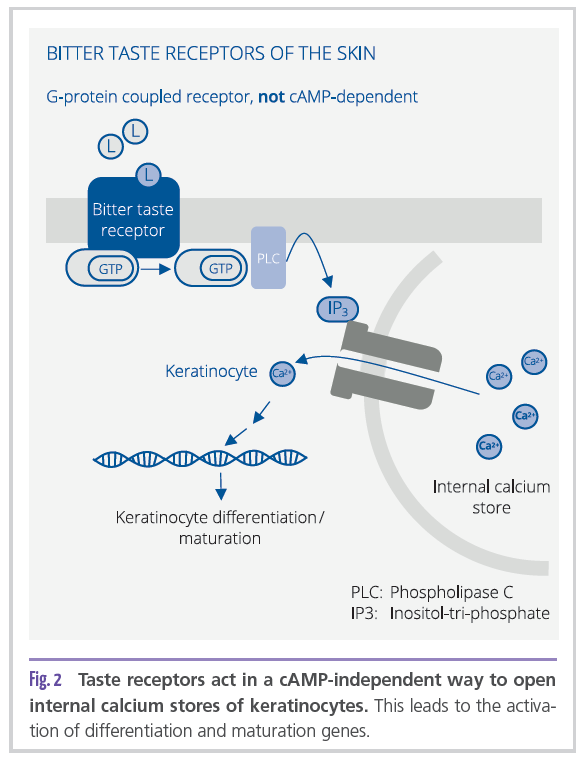
Calcium ions released into the cytoplasm will activate the transcription factors in the same manner as happens with the olfactory receptor pathway. The main difference of the two described pathways is that the first is cAMP dependent, while the latter is not. Both typically lead to an improved keratinocyte differentiation and maturation which is important for proper skin functions [6]. Calcium influx is also reported to have beneficial effects in wound healing [12], depending on the corresponding receptor. Interestingly, some scenting molecules activate both olfactory and bitter taste receptors. Here, we investigate a new extract from the resurrection bush Myrothamnus flabellifolia for its capability to act on those receptors.
Material and Methods
MYRAMAZE®-ESSENCE, in the following Myrothamnus extract, (INCI: Caprylic/Capric Triglyceride, Myrothamnus flabellifolia Leaf/Stem Extract) is the extract from twigs / leaves of Myrothamnus flabellifolia by supercritical CO2 extraction. The resulting oily fraction is diluted in neutral oil.
The essential oil fraction of the extract was determined by steam distillation and analysed by GC-MS/MS for scenting molecules. The fatty acid content was analysed according to DGF C-VI 10a and 11d using standard methods.
The in-vivo studies were performed in accordance with the Declaration of Helsinki of the World’s Medical Association. All study participants signed a written informed consent at the beginning of the study. To evaluate the influence of the product on the stress level, 25 study participants were stressed with a set of standardized arousing images for 2.5 minutes [13]. After 5 minutes, saliva was collected to determine the levels of the stress hormone cortisol and -amylase. Both reflectthe stress level of the study participant. After that, the study participants applied a cosmetic formulation with or without 3% Myrothamnus extract. In order to keep the study double-blind, the formulations were perfumed with vanilla scent, which makes the intrinsic odour of the Myrothamnus extract perceptible only subconsciously.
A set of 10 subjects were allowed to smell the pure product. After 5 minutes, saliva was collected again to detect stress hormones via ELISA.
For the measurement of skin parameters, the product was applied twice daily in a double blind, placebo controlled study. 30 minutes and 24 hours after the first application, measurements were taken without in-between application. 25 subjects applied placebo and 25 subjects applied the same formulation with 1% Myrothamnus extract to the face. A hydration map was generated by measuring 53 spots on the face by corneometry. Significant wrinkle reduction in the crow’s feet area was determined with fringe projection (PRIMOS, not shown). Here, we focused on the dermatological assessment of this parameter.
Results
Fatty acids
The supercritical CO2 extract from Myrothamnus flabellifolia contains about 20 % total fat. The most abundant fatty acids are the two essential –linolenic acid (ALA) and linoleic acid (LA) (3 and 6 fatty acids) and oleic acid as a mono-unsaturated 9 fatty acid (Figure 3). ALA is an important essential fatty acid improving the skin barrier function in activating PPAR receptors [14].
Essential oil and scenting compounds
As Myrothamnus extract is an active with a scent, the presence of fragrance molecules was confirmed by GC-MS/MS. The essential oil fraction contains mainly pinocarveol, germacrene D and pinocarvone (Figure 3). These compounds have herbal, woody, pine, balsamic, floral and minty notes and resemble most of the scent characteristics of Myrothamnus extract. -copaene, trans-carveole and eucalyptol
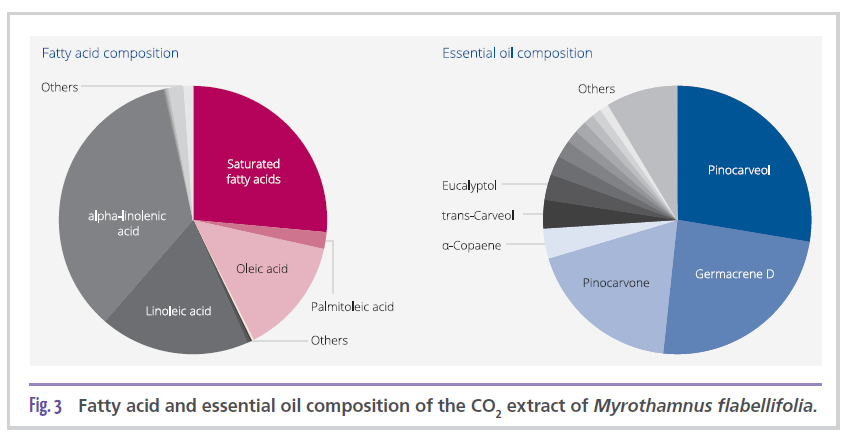
complement the fragrance. Notably, none of the fragrance allergens according to the EU cosmetics regulation are present in amounts that have to be declared in the finished cosmetic product.
Calcium mobilization in keratinocytes
Myrothamnus extract showed a concentration dependent calcium mobilization activity. At 0.01%, an increase by 82% was observed, at 0.1% a significant increase by 288 % (Figure 4). Measurement of the cAMP level revealed no influence of Myrothamnus extract (not shown).
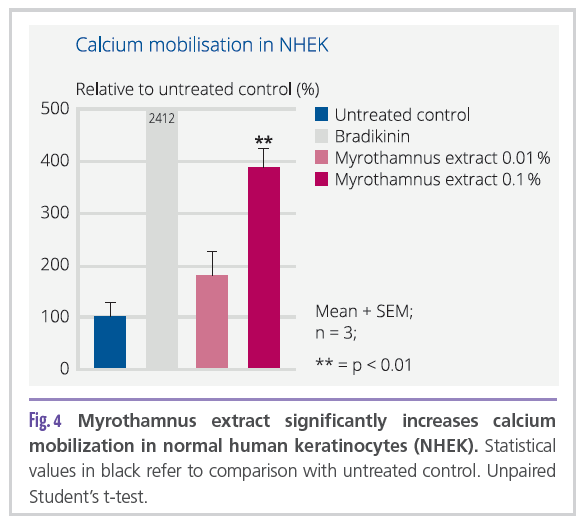
In-vivo stress level determination
Myrothamnus extract is able to reduce the stress level of stressed people. After application of a cosmetic formulation in a stressed condition, both cortisol and -amylase levels were significantly or limit significantly reduced in case 3% Myrothamnus extract was present in the formulation (Figure 5). Placebo was not able to reduce the physiological stress reactions at all. The pure active ingredient in the odour test was able to further decrease the concentration of stress hormones, however not significant due to the reduced number of study participants (10 instead of 25). The physiological reaction is reflected by a more positive mood of the study participants as well as an increase of brain -waves, representing a relaxed mind set (not shown). The effect was measured 5 minutes after product application.
Skin hydration
Skin hydration was assessed with a hydration mapping. 53 spots on the face were analysed with a corneometer.
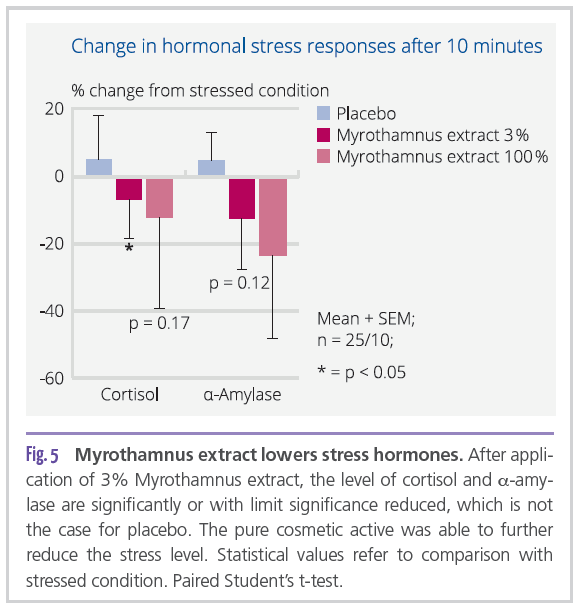
D0 hydration showed an uneven distribution with dry skin areas on the forehead, the cheaks and especially at the nasolabial fold (Figure 6). Application of 1% Myrothamnus extract increased the hydration overall and reduced hydration differences in some areas. Hydration was significantly increased over baseline after 24 hours. Significance over placebo was reached after 7 days.
TEWL
The TEWL was reduced instantly after the application of 1% Myrothamnus extract as suggested by the significant results of the 30 minutes measurement (Figure 7). This advantage lasted for 24 hours and increased during the study duration. After 28 days, TEWL was reduced by 11%, significantly over baseline and placebo. There was no effect of the placebo formulation on the TEWL.
Wrinkle reduction
PRIMOS readings at the periocular region (crow’s feet) revealed a significant improvement over placebo and baseline after 7 and 28 days (not shown). This was confirmed by the dermatological assessment (Figure 8).
Discussion
The production of the fragrant CO2 extract from Myrothamnus flabellifolia takes place with the complete utilisation of the precious plant material. In this process, all the plant material is reused after
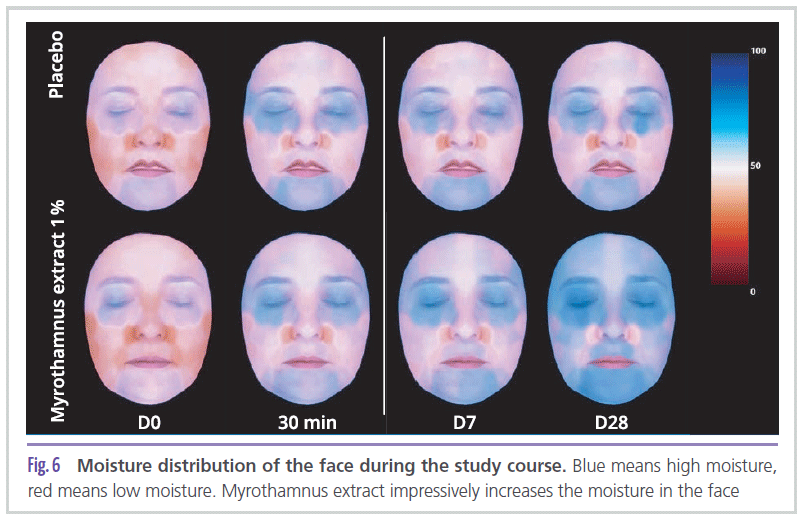
extraction to obtain the sister product MYRAMAZE ®, the aqueous extract of the Myrothamnus plant. MYRAMAZE ®-ESSENCE is thus a plant waste-free active ingredient whose carbon footprint is also offset by compensation projects.
Scenting molecules are able to activate olfactory or bitter taste GPCR receptors. We aimed on confirming that scenting molecules in Myrothamnus extract are able to bind and activate olfactory or taste receptors and induce a calcium influx into the keratinocytes’ cytoplasm. As the detected calcium influx was independent on cAMP, we can conclude that Myrothamnus extract most likely activates bitter taste receptors on keratinocytes.

For testing the Myrothamnus extract’s ability to act on stress of study participants, cosmetic formulations with and without 3% Myrothamnus extract were created. Notably, the scent of the active ingredient, which is barely but perceptibly present at 3%, has been masked by a perfume with a pronounced vanilla note, in order to make the differences between both products indistinguishable for the untrained study participants. After application of the active ingredient, the stress hormone levels were instantly and significantly reduced within minutes. A concentration dependent effect was observed when the study participants smelled on the pure active.
While cortisol reflects the build-up of stress by the hypothalamic-pituitary-adrenal axis activity, -amylase represents the autonomic nervous system, which can hardly be influenced by conscious activities. These body reactions confirm that the scenting molecules in the Myrothamnus extract can activate odour receptors in the nose.
As the Myrothamnus extract is an oily active ingredient, we expected a barrier strengthening, hydrating activity.

Indeed, the analysis of skin parameters revealed a strengthening of the skin barrier as well as an increased hydration. In addition to the physical incorporation of fatty acids into the skin barrier, these effects can be explained by support of the keratinocyte activity due to scenting / tasting molecules. As shown by the in-vitro study, most likely the activation of bitter taste receptors lead to an increased keratinocyte activity due to calcium influx.
However, there are many more effects the Myrothamnus extract is capable of and which we did not show in this article. It can convert dry, sallow skin to a skin with one-of-a-kind radiance, make the skin more elastic and has a lip plumping effect.
Analysis of ageing parameters like wrinkles and roughness completed the evaluations. The supercritical Myrothamnus extract MYRAMAZE®-ESSENCE actually represents the soul of the resurrection bush and revives and rejuvenates our skin. Just as the resurrection bush is given new life by the first drops of rain in the desert.
Authors
Stefan Hettwer*, PhD Emina Besic Gyenge, PhD Brigit Suter, Barbara Obermayer
RAHN AG | Dörflistrasse 120 | 8050 Zürich | Switzerland
*Corresponding Author: [email protected]
References
[1] Atsumi T, Tonosaki K. Smelling lavender and rosemary increases free radical scavenging activity and decreases cortisol level in saliva. Psychiatry Research 2007, 150: 89-96.
[2] Morita E, Fukuda S, Nagano J, Hamajima N, Yamamoto H, Iwai Y, et al. Psychological effects of forest environments on healthy adults: Shinrin-yoku (forest-air bathing, walking) as a possible method of stress reduction. Public Health 2007, 121: 54-63.
[3] Dayawansa S, Umeno K, Takakura H, Hori E, Tabuchi E, Nagashima Y, et al. Autonomic responses during inhalation of natural fragrance of Cedrol in humans. Auton Neurosci 2003, 108: 79-86.
[4] Denda M. Newly discovered olfactory receptors in epidermal keratinocytes are associated with proliferation, migration, and re-epithelialization of keratinocytes. J Invest Dermatol 2014, 134: 2677-2679.
[5] Busse D, Kudella P, Grüning NM, Gisselmann G, Ständer S, Luger T, et al. A synthetic sandalwood odorant induces wound-healing processes in human keratinocytes via the olfactory receptor OR2AT4. J Invest Dermatol 2014, 134: 2823-2832.
[6] Wölfle U, Elsholz FA, Kersten A, Haarhaus B, Müller WE, Schempp CM. Expression and functional activity of the bitter taste receptors TAS2R1 and TAS2R38 in human keratinocytes. Skin Pharmacol Physiol 2015, 28: 137-146.
[7] Lee S, Lee S. Skin Barrier and Calcium. Annals of Dermatology 2018, 30: 265.
[8] Shaw L, Mansfield C, Colquitt L, Lin C, Ferreira J, Emmetsberger J, et al. Personalized expression of bitter ‘taste’ receptors in human skin. bioRxiv 2018: 364901.
[9] Dalesio NM, Barreto Ortiz SF, Pluznick JL, Berkowitz DE. Olfactory, Taste, and Photo Sensory Receptors in Non-sensory Organs: It Just Makes Sense. Frontiers in physiology 2018, 9: 1673-1673.
[10] Kinnamon SC. Taste receptor signalling - from tongues to lungs. Acta physiologica (Oxford, England) 2012, 204: 158-168.
[11] Yoshida Y, Imai S. Structure and function of inositol 1,4,5-trisphosphate receptor. Jpn J Pharmacol 1997, 74: 125-137.
[12] Tsai T, Veitinger S, Peek I, Busse D, Eckardt J, Vladimirova D, et al. Two olfactory receptors-OR2A4/7 and OR51B5-differentially affect epidermal proliferation and differentiation. Exp Dermatol 2017, 26: 58-65.
[13] Kurdi B, Lozano S, Banaji MR. Introducing the Open Affective Standardized Image Set (OASIS). Behav Res Methods 2017, 49: 457-470.
[14] Farage M, Miller K, Maibach H. Textbook of Aging Skin; 2010.






